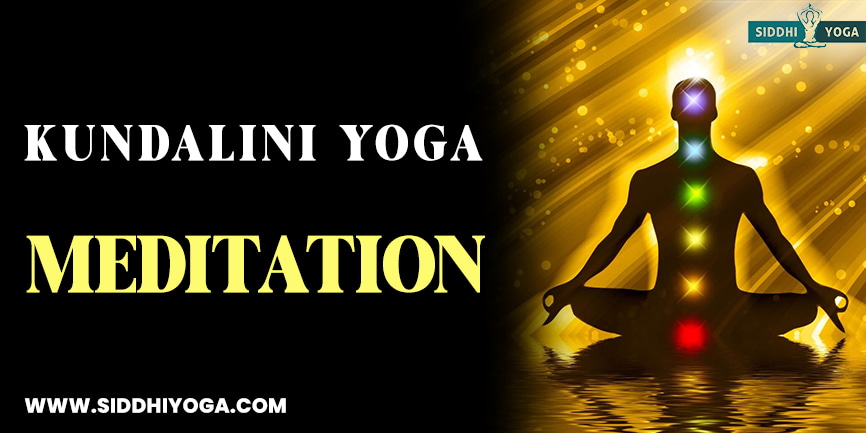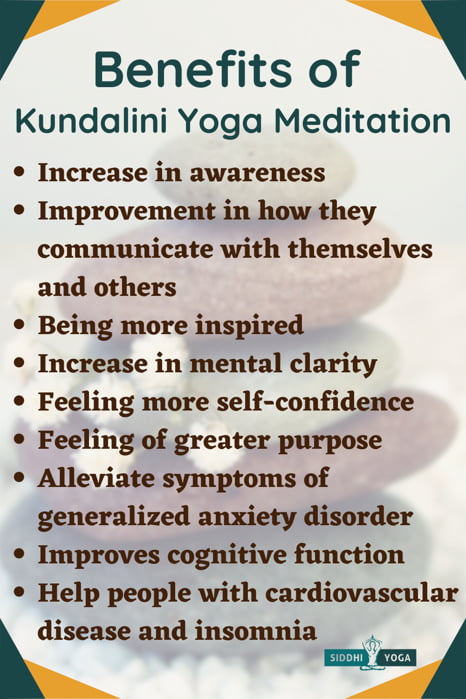
Do you want to achieve enlightenment? Learn Kundalini Yoga meditation, the school of yoga that awakens your full potential for awareness of the spiritual.
Introduction
Kundalini is a powerful style of meditation that can help you achieve enlightenment through a combination of different techniques. In this article, you will learn everything you need about Kundalini Yoga meditation, its potential benefits, how to practice it, and other meditation styles to help you achieve your goal.
Intro to Kundalini Yoga
“Kundalini” is a Sanskrit term meaning “coiled,” as it lies at the base of your spine (Root chakra), coiled like a snake. It is a specific type of meditation that may help you achieve the ability to have full awareness, awakening, or enlightenment.
Where Kundalini came from is not clear. However, according to studies, it has been practiced in India since 500 BCE. Practitioners of Kundalini believe that everyone has the divine within them. This divine sometimes lays dormant and needs an awakening.
In the west, Yogi Bhajan popularised the Kundalini Yoga meditation. He developed and introduced his style of Kundalini yoga in the United States in the late 1960s. Since then, it has become popular.
Potential benefits

Practitioners of Kundalini yoga meditation report the following benefits:
- Increase in awareness
- Improvement in how they communicate with themselves and others
- Being more inspired
- Increase in mental clarity
- Feeling more self-confidence
- Feeling of greater purpose
Scientifically Backed Benefits
According to this small study in 2017, Reduced Stress shows that Kundalini yoga meditation significantly decreased the perceived stress of people in a control group after practicing it for three months.
The researchers from this study also suggest that Kundalini yoga meditation may help people with cardiovascular disease and insomnia.
A 2018 study suggests that Kundalini yoga may alleviate symptoms of generalized anxiety disorder.
A study published by the International Psychogeriatrics, Cambridge University Press, also claims that practicing Kundalini improves cognitive function. The study indicates that Kundalini yoga enhances memory and executive function in 81-year-old adults more than in memory enhancement training.
Kundalini Yoga meditation
A Kundalini meditation combines a few techniques to unite with the divine feminine energy. These techniques are called Kundalini kriyas. These are:
Pranayama
Pranayama is a Sanskrit term that comes from the words “prana,” which means life force, “yama,” which means expansion or extension, and “ayama,” which means control. It means the expansion of the breath or breath control.
Pranayama is a big part of Kundalini yoga. Depending on the Kundalini yoga teacher or the theme of the yoga class, the specific type of Pranayama you practice in the class will be different.
The Pranamayas Kundalini yogis practice include:
Long Deep Breathing: This type of breathing exercise is suitable for beginners since it doesn’t involve complex suspension or extension of the breath. It only consists of breathing deeply and slowly through your nostrils.
Breath of Fire: This breathing exercise involves quick and rhythmic inhales and exhales that practitioners need to sustain for a certain period.
Nadi Shodhana: You may know this Pranayama as Alternate Nostril Breathing. It’s a breathing exercise that balances the brain’s Nadis or left and right hemispheres.
Mudras
Mudras are hand gestures that are necessary aspects of a Kundalini yoga meditation practice. Kundalini yogis believe that hands have connections with the brain. You can lock in energy or stimulate it by doing various hand placements.
Gyana Mudra is the most common hand gesture in a Kundalini yoga practice. This Mudra directs energy and maintains focus on that energy. You can do this by bringing your thumb and index fingers together.
Mantras (Phrases)
Chanting mantras or phrases is another essential technique in practicing Kundalini yoga. It is a phrase you utter internally or could be spoken out loud and repeated. It is a vibration or sound that helps the practitioner enter into a deep state of meditation.
A common mantra you chant in Kundalini Yoga is “Sat Nam.” It comes from the Sanskrit words “Sat,” which means truth, and “Nam,” which means name. It can mean, “I am the truth,” or “Truth is my essence.”
Physical Movements
The physical movements in Kundalini yoga differ from that of Hatha Yoga. In Kundalini yoga, you do the movements while in a seated posture.
One of the most common physical movements Kundalini yogis practice is the Ego Eradicator. You do this by sitting in Sukasana or easy pose, folding the four fingers while sticking the thumb out, and bringing the arms overhead at a 45-degree angle. Practicing this movement opens the lungs and brings you into an alert state. You usually practice it with the breath of fire in the morning or midday for a quick energy boost.
Takeaway: Kriyas mean completed action. You have achieved the exercises necessary to rouse the Kundalini when you practice these exercises. The Kundalini will now be ready to move along your chakras (energy centres) until it reaches the seventh chakra. This Sahasrara chakra sits at the crown of the head and is the centre for ultimate wisdom and enlightenment.
How to Practice Kundalini Yoga Meditation
There are thousands of ways to do a Kundalini Yoga meditation. It depends on the specific outcome you wish to achieve. You are doing it correctly as long as the kriyas are all present. If you have a particular concern and you want to be your focus, ask for a Kundalini yoga teacher to offer you guidance.
The structure of a basic Beginner’s Kundalini yoga meditation could look like this:
- Prepare for meditation. As much as possible, do it when there are fewer distractions, such as in the early morning or before bed. Wear something light and loose. Practitioners of Kundalini yoga believe that wearing light clothing attracts lightness. They also think wearing a shawl or a headcover promotes energy flow.
- Once ready, sit on a chair, a bolster, or directly on the ground. You can do any meditation posture. Find the seated posture that you can sustain throughout the whole duration of your meditation. Then, bring your hands in Anjali Mudra or prayer hands in front of your chest and close your eyes. Start tuning into your body by noticing the sensations you feel.
- With your eyes still closed, bring your Drishti or gaze towards the Third Eye chakra, which sits between your eyebrows. Focus on the Third Eye chakra.
- Use a mantra. Mantras help direct your focus. You can recite any mantra you like at any pace that’s comfortable for you. You can start with Sat Nam if you are new to this type of meditation. If Sat Nam or any mantra you come across doesn’t resonate with you, don’t force it.
- Begin bringing your awareness towards your breath. Notice your inhales and exhales, their duration, the temperature, and how your body feels as you do them. Then start practicing Pranayama. You can begin with deep breathing, inhaling, and exhaling for 3 to 4 seconds.
- After a while, start doing a Mudra or a hand gesture. You can do the gyana Mudra, bringing the tip of your thumb and pointer finger together. This Mudra promotes wisdom and creativity.
- Bring your attention back to your breath. Then start dividing the breath into equal segments. So instead of inhaling and exhaling for 4 seconds, you inhale four times, then exhale four times while making sure that you draw your navel in as you inhale and exhale. This breathing exercise is the breath of fire. Each inhale and exhale should be quick, but the rhythm depends on you. Do this for a few minutes. If the mind wanders away from the breath, gently bring your awareness back to it without judgment.
- Return your attention to your breath when it wanders without judgment. Even long-time meditation practitioners do this. What matters is that you go back to the breath.
- End your meditation with one deep inhale and one slow exhale. Then fold your fingers, stick your thumb out, and raise your arms overhead for an Ego Eradicator.
The Kundalini Yoga Organisation suggests practicing Kundalini Yoga meditation every day for 40 days to break negative habits and build good habits.
Gong in Kundalini Meditation
The Gong is sacred in Kundalini yoga. When you first attend a Kundalini yoga class, you will notice a gong and how it is used after a session. But it is more than just a musical instrument.
In Kundalini yoga, a gong is a physical representation of the subtle world. Each part of it represents different realms and produces a different sound. The centre of the gong represents the sun. The outer part is nature. The outer part is the mind.
A Kundalini yoga meditation revolves around the gong. You hear this during deep relaxation, after you practice the kriyas, and before meditation. However, it depends on the teacher and the instructions from Yogi Bhajan.
The sacred sound of the gong may improve your Kundalini yoga experience. You may feel its sound vibrate through your body and impact your mind and spirit differently.
Kundalini Yoga Meditation Alternatives
Kundalini Yoga meditation has benefits for your general well-being. But if, for some reason, it doesn’t work for you, there are other types of meditation you can practice. Here are three Kundalini Yoga Meditation alternatives you can choose from:
Loving Kindness Meditation
This type of meditation is simple yet complex, as some resist giving and receiving loving-kindness. It involves repeating certain phrases to convey loving-kindness towards yourself first, then to people you love, people you may have negative feelings with, and finally to all beings in the world.
Sahaja Yoga Meditation
Sahaja Yoga Meditation is quite similar to Kundalini Yoga meditation. Practitioners of this type of meditation awaken the Kundalini and raise it towards the Crown or Sahasrara Chakra to unite with the divine. However, they don’t necessarily practice Pranayama, Mudras, and the kriyas in Kundalini Yoga meditation.
Mindfulness Meditation
Mindfulness meditation is another alternative to Kundalini yoga meditation that you can practice. Depending on the teacher, a mindfulness meditation session may involve chanting mantras, doing Pranayama, and a Mudra. Thus, it is quite similar to Kundalini yoga.
The Bottomline
Kundalini Yoga meditation is a powerful practice that has the potential to bring about significant personal transformation. It combines physical postures, breath control, and focused meditation to awaken the dormant energy in the base of the spine, known as kundalini energy. However, it is important to approach Kundalini Yoga meditation with caution, as the awakening of kundalini energy can sometimes lead to intense physical and emotional experiences. It is recommended to practice under the guidance of an experienced teacher and to maintain a consistent meditation practice to fully realize the benefits of this powerful technique.
Would you like to explore the advantages of meditation? If so, come and join our 30-day Meditation Challenge to witness transformative benefits in your life!